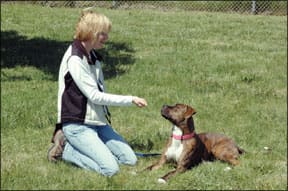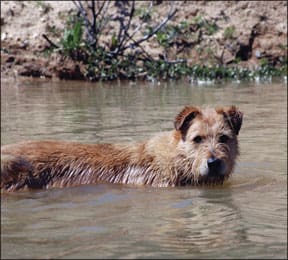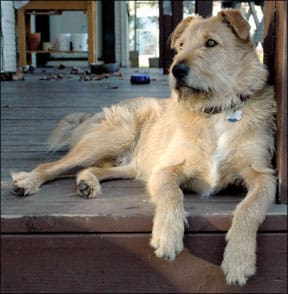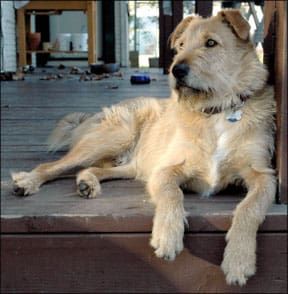Last month I mentioned how our daily off practice paid off when Otto first noticed my friend Leonoras goats. Otto is fascinated by these animals, which puff up like cats, rear up like horses, and make very weird, scary direct eye contact very undoglike. As riveted as he was by the goats, every time I said, Otto, off! he immediately turned away from the goats and looked at me. Of course, I delivered a bit of hot dog his favorite treat right to his lips, each time he so much as glanced at or stepped toward me. It was a calm, drama-free event; no goats or dogs were harmed in the making of that particular scene.
288
It was a great testimonial for the effectiveness of positive training in general, and specifically for an all-positive method of training a dog to exert self-control. I wasnt yelling at Otto, scaring him (and any other creature around), or threatening his general well-being if he made the wrong move. It wasnt fear of punishment or fear of me or some sort of amorphous respect that he had for me, or his recognition of my leadership that led him to resist his desire to chase or otherwise engage the goats. It was simply another step along a deliberately built, assiduously practiced, behavior modification program. How did you teach him that? Leonora wondered.
She was particularly curious because she worries every spring and summer about her dogs getting bitten by rattlesnakes (they are very common in this part of Northern California) and the only methods of so-called snake-proofing that she had been able to find involved shock collars which, fortunately, she hadnt liked the idea of, without really knowing why. I hastened to assure her that shock collars and every other type of punishing aversive were not only unnecessary, but also potentially damaging to her relationship with her dogs. And that the positive approach had many more daily applications than snake-proofing.
I tried to explain how it was an extension of a basic Dont touch! exercise, but the more that Ive thought about it, the more I realize that it is also emblematic of the relationship-building power of positive training in general.
Choices
First, as a dog owner, you have to realize that a dog is a dog; he possesses natural desires genetically programmed, most-likely responses to many types of stimuli. You are not trying to teach him about right and wrong nor about obeying you. You are simply trying to modify his natural responses to make them more convenient to you. Positive training not only accomplishes this goal, but also has the side effect of giving the dog a strong desire to do the things youd like him to do, increasing the odds that hell change his behavior in just the way you would like him to. Think of it as team-building!
In a thoughtful positive training program which is what I strive to employ with Otto the goal is to teach the dog some basic, all-purpose responses that can be applied in progressively more and more challenging environments, with tiny successes at each level leading to a greater likelihood of success at each and every level of difficulty.
Using the procedure described in detail by Pat Miller in Request For Leave (WDJ August 2008), I started teaching Otto the Off! or Dont touch! exercise by putting a delicious treat in my closed fist, and holding the fist right under Ottos nose. He could smell the treat, and licked and nosed my hand to try and get it. The moment he looked away or moved away from my hand (and the treat), Id mark the moment by saying Yes! (Miller uses the click! of a clicker) and give him a treat from my other hand.
Otto quickly learned that the only way to get a treat was to ignore the one right in front of him. As soon as it was clear he got the concept of the exercise, I added a verbal cue: Off! (Some people prefer Leave it! or Dont touch!) The next step was to open my hand so he could see the treat in addition to smelling it quickly closing my hand on the treat if it seemed like he was about to grab it. Id also place a treat on the ground and say, Off! If he tried to get it, I could slide one of my feet over the treat to keep him from getting it. And the moment he looked away from the treat, Id give him a different treat.
288
Such a simple exercise with such powerful applications. In learning this exercise, a dog learns to resist his first instinct (grab the treat) and delay his gratification not a particularly dog-like thing to do! He also learns that you are highly likely to deliver a more delicious treat, or more of them, if he resists his urge to take the seemingly more accessible one.
Im fascinated by the fact that, when denied access to the easy treat, most dogs will naturally look at their handlers face, looking for a clue as to when their reward will come. This glance grows into a gaze, and, when its frequently reinforced with meaningful rewards, the gaze itself becomes a default behavior for the dog that precludes him from doing things you dont want him to do, such as see (and then chase) a squirrel, or see (and engage with) another dog.
Otto and I practice Off every day we are together. We practice in highly controlled conditions, such as feeding time, when I dont put his bowl of food on the floor until he offers a sit and looks at me, and then holds that sit (and gaze) until I put the bowl down and release him to eat. A few times a day, I formally practice and reinforce the puppy kindergarten-level Off! exercise, with a treat in my hand,. But I also try to train informally throughout the day. For example, when making myself a sandwich for lunch, I might accidentally drop a piece of roast beef and say Off! as hes reaching for it. Im careful to position myself to be able to quickly block his access to it with my foot or leg, so he doesnt get reinforced for diving for the food anyway. (He does ultimately get that piece of beef, and more, when he looks away from the fallen piece.)
I say Off! when he hears someone walking down the sidewalk in front of our house, and instead of barking, he looks at me. If I dont have a treat in my pocket, I make sure to raise him and take the time to give him a few moments of scratching his favorite itchy places. I say Off! when he looks at the cat as she scratches her favorite scratching post in the backyard; Otto and I both know that she often follows up a scratching session with a wild-kitty dash across the yard, so the Off in this case is a proactive preventative.
I also practice the Off exercise when we play fetch and tug, and when Otto comes to nudge my elbow as Im working at the computer. I might tell him Off when we are greeting someone on the street, if it seems to me that his proximity is making someone nervous. And I use it a lot on our walks and bike rides. When I see him see something like a feral cat, a squirrel on a wire, a robin hopping along the ground, or an aroused-looking dog running along a fence, I say Off and reward, reward, reward him when he looks away from the thing and looks back at me.
288
Rewards
Does that mean Im always wearing a bait bag full of treats? In our first year together, yes, I always wore a bag full of delicious treats when I took Otto out for a walk or bike ride, or brought him to a friends house. Were celebrating our first anniversary together at the end of this year. The bait bag is staying at least a while longer, because if I wasnt a reliable supplier of rewards that are more valuable to him than whatever else it is that he wants, Im sure hed eventually do the math and realize that chasing the squirrels or whatever was far more rewarding than my praise alone. When he resists something thats high on his personal fun scale, I try to reward him accordingly, with a jackpot of treats and perhaps a quick game of tug of war with the leash. At home, in the yard, praise and petting rank high on the Otto satisfaction scale. Out in the world, they arent worth as much. Its like taking dollars to Europe!
I also try to mix it up. Sometimes he wins a piece of hot dog; sometimes I reach past the hot dog to a piece of cheese. Sometimes there are sardines in the bag wow! Sometimes he gets one piece; every so often Ill dump the entire contents of the bait bag onto the ground! Hes won the lottery! I think of it like that TV show, Lets Make a Deal. If someone always knew what was behind Door Number One, it would take the fun out of choosing that option.
This sounds like a lot of work. Added up over our first year together, it is, and yet the daily average is probably less than 10 minutes a day. Weve had days where I trained, off and on, for hours. And other days when Ive maybe asked him to do one simple thing all day.
But Im happy to do the work. I enjoy working with him and seeing his enjoyment at working with me. I love watching his face as he tries to puzzle out what Ive asked and what he has to do to win a reward of food, petting or just my momentary attention. And Im happy to do the work because Im highly motivated to help him become a dog that I can take anywhere with ease and comfort, secure in the knowledge that he wont cause problems for anyone. I plan on having this dog for decade and more, and I consider the time I spend training now to be an investment in our future together.
Nancy Kerns is Editor of WDJ. She adopted Otto on June 13, 2008.






